Scottish maternal and infant nutrition survey 2017
Results from the 2017 Scottish Maternal and Infant Nutrition Survey. This first Scotland-only survey gathered data on maternal nutrition and infant feeding.
5. Infant Nutrition: Breastfeeding
It is widely accepted that breast milk provides the best source of nutrition for infants and young children. ( R25) There is a large body of research that has established strong evidence of the health benefits of breastfeeding, both for children and mothers. ( R26-R28) Many of these positive impacts on health are known to increase the longer breast feeding is sustained.
In line with these recognised nutritional and health benefits of breastfeeding, since 2001 the World Health Organisation ( WHO) has recommended: ( R29)
- Exclusive breastfeeding for the first six months of an infant's life.
- Continued breastfeeding alongside appropriate complementary foods up to two years of age or beyond.
Exclusive breastfeeding is defined by WHO as giving no other food or drink, including water (with the exception of the administration of medicines, vitamin drops and oral rehydration solution). ( R29) The WHO recommendations have been adopted as policy by the Scottish Government. ( R1 )
The following section of this report presents information on the incidence and prevalence of breastfeeding reported by postnatal survey respondents. It also looks at the duration of breastfeeding (drop-off) and the challenges women said they experienced while breastfeeding.
- The incidence of giving breast milk is defined as the proportion of all respondents who have ever given breast milk to their baby.
- The prevalence of giving breast milk is defined as the proportion of all respondents who were giving breast milk to their infant at a specified age.
- Drop-off is defined as the proportion of respondents, who had ever given breast milk to their baby, but who had stopped by a given point in time.
5.1 Incidence of giving breast milk
Three-quarters of respondents to both postnatal surveys had "ever" breastfed and/or expressed breast milk for their new baby (75% for the 8-12 week survey; 76% for the 8-12 month survey). This includes mothers who only gave breast milk in the first hours following their baby's birth and mothers who continued to give breast milk for days, weeks or months.
[Figure 5.1; Table 5.1a & 5.1b]
Older mothers and those who lived in the least deprived areas were more likely to have ever breastfed and/or expressed breast milk for their baby.
Figure 5.1: Have you ever breastfed or expressed breast milk for your new baby? (Percentage of respondents who indicated that they had ever given breast milk to their new baby, by respondent age, deprivation, and by whether this is respondent's first baby). [18]
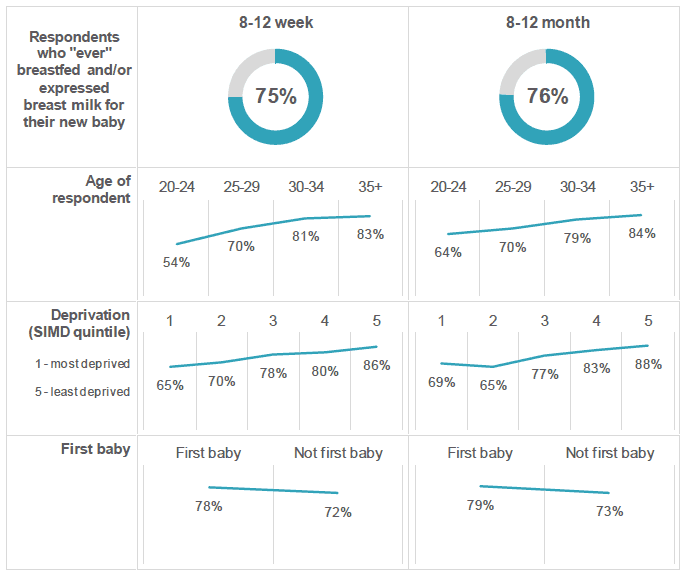
Source: Q29,Q58, Q18, 8-12 Week Survey
Q26, Q50, Q1, 8-12 Month Survey
The overall proportion of respondents who reported ever giving breast milk to their new infant was very similar for each postnatal survey. Each survey also showed similar trends across different groups of respondents:
- Older mothers were more likely to have given breast milk than younger mothers.
- Mothers who lived in the least deprived areas were more likely to have given breast milk than those who lived in the most deprived areas.
- First time mothers were more likely to have given breast milk than respondents who already had children.
[ Figure 5.1; Table 5.1a & 5.1b]
Comparison to 2010 UK-wide Infant Feeding Survey
Although results from the 2010 UK-wide Infant Feeding Survey ( IFS) ( R7) and this survey are broadly comparable, it should be noted that the methodology and the wording of the related question were slightly different in each survey.
In the 2010 survey, the reported incidence of Scottish mothers "ever" giving breast milk was 74%. Results from the 2010 survey also showed a similar pattern across age groups, deprivation categories and by birth order:
- 61% of Scottish respondents aged 20-24 in the 2010 IFS had ever given breast milk to their baby, compared to 82% of those aged over 30.
- In the 2010 IFS, 60% of Scottish respondents who lived in the most deprived areas had ever given breast milk, compared to 88% in the least deprived areas.
- 77% of Scottish first time mothers in the 2010 IFS reported that they had ever given breast milk; the equivalent figure for previous mothers was 72%.
Comparison to official Scottish National Statistics
Information on the incidence of ever giving breast milk is also available from official Scottish Infant Feeding Statistics. ( R9) These statistics are based on information collected from around 98% of registered live births at the first Health Visitor review, when a child is usually between 10-14 days old. Note that the incidence of ever giving breast milk reported in the current survey is markedly higher than that reported in the official national Infant Feeding Statistics for Scotland (63%).
It is acknowledged that information collected via surveys such as the MINS and the IFS may overestimate rates of women giving breast milk. This can be attributed to the fact that older women in less deprived areas are both more likely to respond to this type of survey and to give breast milk. Although the survey results have been weighted to adjust for differential response by age group, deprivation and NHS board of residence, this will not fully account for the fact that women who are more likely to give breast milk are also more likely to have responded to this survey.
Nevertheless, the variations apparent amongst different groups of mothers as reported by the official national Infant Feeding Statistics for Scotland are broadly similar to those reported in the current survey and the earlier UK-wide Infant Feeding Survey. Official national Scottish Infant Feeding Statistics for 2016/17 reported that:
- 44% of mothers aged 20-24 had ever given breast milk to their baby, compared to 75% of those aged 35-39 and 76% of those aged 40 or over.
- 47% of mothers who lived in the most deprived areas had ever given breast milk, compared to 82% of those living in the least deprived areas.
Incidence by NHS board of residence
There was variation across Scotland in terms of the proportion of respondents who reported ever giving breast milk to their new baby; this pattern of regional variation was similar across both postnatal surveys. The lowest rates were reported in NHS Lanarkshire and NHS Ayrshire & Arran; the highest rates were reported in NHS Lothian and NHS Borders. [19]
[Table B3: 8-12 Week & C3: 8-12 Month – Results by Board]
There are a number of reasons that may explain these differences. As outlined above, younger mothers and those who live in areas of higher deprivation are generally less likely to give breast milk; therefore NHS board areas with higher proportions of these groups will generally have a lower incidence of mothers giving breast milk.
Similar regional variations are reflected in the official national Infant Feeding Statistics for Scotland, with low rates of ever giving breast milk reported in NHS Lanarkshire and NHS Ayrshire & Arran, and high rates in Lothian. ( R9)
Incidence by feeding intention (8-12 week survey)
In general, respondents to the 8-12 week survey who had decided before the birth how they planned to feed their new baby carried out their intention.
- Nearly all respondents who had intended to breastfeed / express breast milk only did give breast milk to their new baby at some point (96%).
- Likewise, a large proportion (89%) of those who planned to mix feed (combine breastfeeding and formula feeding) went on to give breast milk at some point.
- Amongst those who intended to formula feed only, a small proportion (5%) reported that they had given breast milk to their baby.
- 64% of respondents who had been undecided about how to feed their baby reported that they had given breast milk to their baby at some point.
[Figure 5.2; Table 5.2]
The vast majority of mothers who intended to breastfeed / express breast milk for their new baby did so at some point.
Figure 5.2: Have you ever breastfed or expressed breast milk for your new baby? (Percentage of respondents who indicated that they had ever given breast milk to their new baby, by feeding intention prior to birth).
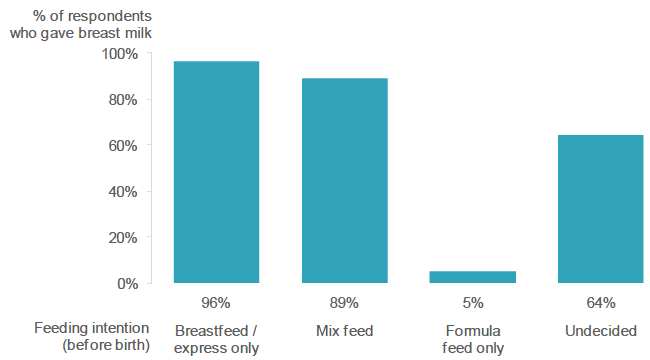
Source: Q29, Q21, 8-12 Week Survey
It should be noted that these questions asked new mothers to recall their pre-birth feeding intentions retrospectively. As a result, some respondents may have had difficulty in accurately recalling their pre-birth feeding intentions. Furthermore, respondents' answers may have been influenced by their actual experience after giving birth.
The 2010 IFS also found that most mothers who had decided before the birth how they planned to feed their baby went on to carry out their intentions, at least initially. ( R7)
Other factors associated with incidence of ever giving breast milk (8-12 week survey)
Other factors were found to be associated with the incidence of ever giving breast milk:
- Previous feeding experience: Respondents who had breastfed / expressed milk before were more likely to give breast milk to their new baby. This likelihood increased depending on the length of time that a mother had previously given breast milk (previous mothers who had never given breast milk 19%; previously given for < 2 months 74%; 2- < 6 months 94%; 6+ months 99%).
- Skin-to skin contact: Respondents who had skin-to-skin contact with their baby within an hour of the birth were more likely to report giving breast milk (77%) than those who had not had this contact (63%).
[Table 5.2]
The incidence of ever giving breast milk was found not to be associated with the following factors:
- Gestation period: There was no significant difference in the incidence of giving breast milk between respondents who had given birth prematurely (before 37 weeks) and those who had reached full term (79% and 75% respectively). However, it should be noted that only 5% of respondents gave birth prematurely. Amongst a very small group of respondents (0.5%) who had given birth before 32 weeks, all had breastfed or expressed milk for their new baby at some point.
- Extra care: There was no significant difference in the incidence of giving breast milk between respondents whose babies had spent time in any type of extra care (special care baby unit, neonatal unit, transitional care ward or a children's hospital) and those whose babies had not (79% and 74% respectively). However, it should be noted that only 13% of respondents had a baby that spent time in this type of care.
- Birth weight: There was no significant difference in the incidence of giving breast milk to infants of different birth weights; note that the majority (81%) of babies in this survey were found to be of normal birth weight.
[Table 5.2]
5.2 Giving breast milk in the early days
Feeding on leaving hospital / maternity unit (8-12 week survey)
On leaving hospital / the maternity unit, just over half of all respondents were exclusively giving breast milk (53%), with a further 16% mix feeding (giving both breast and formula milk) and 30% giving formula milk only. [20], [21]
Of respondents who had ever given breast milk to their new baby, the vast majority (92%) were doing so on leaving hospital / the maternity unit; 71% were giving breast milk exclusively and 21% were mix feeding. Seven percent (7%) of these respondents were giving formula milk only.
[Figure 5.3; Table 5.3a & 5.3b]
The majority of respondents were giving breast milk to their baby when they left hospital / the maternity unit.
Figure 5.3: Which statement best describes how you were feeding your baby when you left the hospital / maternity unit? (Percentage of respondents who indicated each method. All respondents / respondents who gave breast milk).

Source: Q32, Q29, 8-12 Week Survey
In the 2010 IFS, 73% of respondents across the UK who had ever given breast milk to their baby were exclusively giving breast milk when they left hospital / the maternity unit. Only 16% were mix feeding, with 10% giving formula milk only. ( R7)
Ability to recognise if baby was getting enough breast milk (8-12 week survey)
Nearly two-thirds of respondents (64%) who had ever given breast milk to their new baby said that they had been offered an explanation, shortly after the birth, about how to recognise whether their baby was getting enough breast milk. Fifty-eight percent (58%) had received this explanation, while 6% had declined the offer of an explanation. Just over a third of respondents (35%) had not been given or offered an explanation.
[Table 5.4]
In the 2010 IFS, 54% of Scottish respondents who had given birth in hospital / a maternity unit, and who had given breast milk, said that somebody had explained to them how to recognise whether their baby was getting enough milk. ( R7)
Overall, a third of respondents (33%) who had given breast milk felt that they could "definitely" recognise whether their baby was getting enough milk. A further 30% felt that they "probably" could. Thirteen percent (13%) were unsure, and 13% felt they "probably" could not. Seven percent (7%) said that that they "definitely" could not recognise whether their baby was getting enough milk.
[Table 5.5]
The ability to recognise whether a baby was getting enough breast milk was related to whether an explanation had been offered.
- 82% of respondents who had declined the offer of an explanation said that they felt able to recognise whether their baby was getting enough milk (61% "definitely" and 20% "probably").
- However, only 35% of respondents who had not been offered an explanation said that they could recognise whether their baby was getting enough breast milk (16% "definitely" and 19% "probably").
[Figure 5.4; Table 5.5]
Respondents who had been offered an explanation about how to tell if their baby was getting enough breast milk, felt more confident about recognising whether their baby was getting enough.
Figure 5.4: Shortly after the birth of your baby, did you feel that you could recognise whether your baby was getting enough breast milk? (Percentage of respondents who selected each statement, by whether an explanation had been offered. Respondents who gave breast milk).
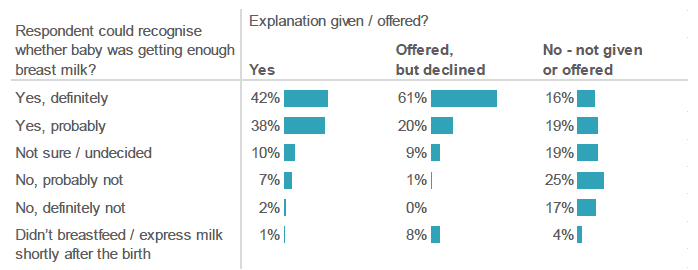
Source: Q34, Q33, 8-12 Week Survey
5.3 Prevalence of giving breast milk
The prevalence of giving breast milk is defined as the proportion of all respondents who were giving breast milk to their infant at a specified age, even if the baby was also receiving infant formula or complementary foods.
Prevalence of giving breast milk in the first six weeks (8-12 week survey)
Seventy-five percent (75%) of respondents to the 8-12 week survey indicated that they had given breast milk to their new baby at some stage. By the time that infants were four days old, 69% of respondents reported that they were giving breast milk (a drop of six percentage points). After one week, prevalence had fallen further to 66% (a drop of nine percentage points from the initial rate).
The prevalence of giving breast milk continued to decline, at a slower rate, with each passing week. By the time infants were six weeks of age, 55% of respondents reported that they were giving breast milk (a drop of 20 percentage points from the initial rate). Drop-off rates are discussed in more detail in section 5.4.
[Figure 5.5; Table 5.6a]
Fifty-five percent of respondents reported giving breast milk by the time infants were six weeks old.
Figure 5.5: Prevalence of giving breast milk. (Percentage of respondents giving breast milk on or after various time periods up to six weeks after the birth).
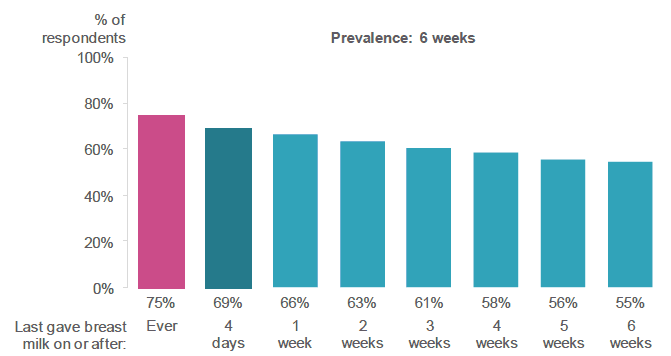
Source: Q29, Q31, 8-12 Week Survey
The 2010 IFS reported that the initial rate for Scottish respondents fell from 74% to 64% by the time that infants were four days old, to 61% by one week, to 58% by two weeks, and to 50% by six weeks. ( R7,) [22]
Prevalence in the first six weeks by age and deprivation (8-12 week survey)
There was some variation in the prevalence of giving breast milk at six weeks depending on the respondent's age and the level of deprivation in their area of residence:
- 54% of respondents aged 20-24 indicated that they had ever given breast milk to their baby. By the time that infants were six weeks old, only 29% reported that they were giving breast milk (a drop of 25 percentage points).
- Amongst mothers aged 35 and over, the initial rate fell from 83% to 65% at six weeks (18 percentage point drop).
- For respondents who lived in the most deprived areas, the initial rate fell from 65% to 45% by six weeks (20 percentage point drop).
- Amongst respondents who lived in the least deprived areas, the initial rate fell from 86% to 67% by six weeks (19 percentage point drop).
[Figure 5.6; Table 5.6a & 5.6b]
The prevalence of giving breast milk at six weeks varied by respondent age and deprivation.
Figure 5.6: Prevalence of giving breast milk by age and deprivation. (Percentage of respondents giving breast milk to their new baby ever and at six weeks, by respondent age and deprivation). [23]
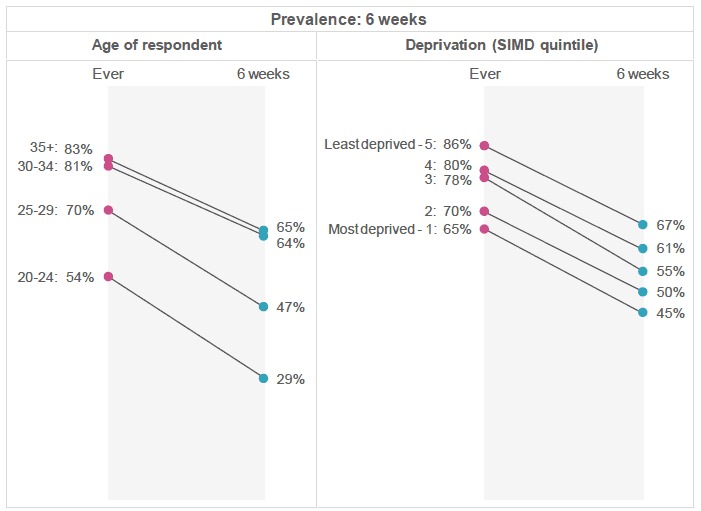
Source: Q29, Q31, Q58, 8-12 Week Survey
Prevalence in the first six weeks by other factors (8-12 week survey)
There were a number of factors associated with the prevalence of infants receiving breast milk at six weeks old:
- Feeding intention prior to birth: Over three-quarters of mothers (77%) who had intended to breastfeed / express milk only before their baby was born were giving breast milk at six weeks. This compared to 47% of those who had intended to mix feed, 30% of those who had been undecided and only 1% of those who had intended to formula feed.
- Previous feeding experience: Fifty-three percent (53%) of first time mothers were giving breast milk at six weeks. Amongst respondents who already had children, prevalence at six weeks varied according to the length of time that a mother had previously given breast milk (previous mothers who had never given breast milk 11%; previously given for < 2 months 29%; 2- < 6 months 77%; 6+ months 97%).
- Feeding method(s) on leaving hospital: Eighty-six percent (86%) of respondents who were exclusively giving breast milk when they left hospital were giving breast milk at six weeks, compared to 53% of those who were mix feeding on leaving hospital. Only 2% of mothers who had been exclusively giving formula milk when they left hospital were giving breast milk at six weeks.
[Table 5.6c & 5.6d & 5.6e]
Prevalence: how babies were being fed at 8-12 weeks
Respondents to the 8-12 week survey were asked whether they were breastfeeding or expressing breast milk for their baby at the time of completing the survey, and if so, whether their baby was being given breast milk exclusively or being mix fed (given breast milk and formula milk).
Fifty-one percent (51%) of respondents reported that they were giving breast milk at the time of survey completion; 37% were exclusively giving breast milk, while a further 14% were mix feeding. The remaining 49% were giving formula milk to their babies.
[Figure 5.7; Table 5.7]
Half of respondents were giving breast milk at the time of survey completion (8-12 week survey).
Figure 5.7: Are you still breastfeeding or expressing breast milk for your baby now? (Percentage of respondents who indicated each feeding method).

Source: Q30, Q29, 8-12 Week Survey
The 2016/17 official national Infant Feeding Statistics for Scotland reported that 41% of infants were being given breast milk at the time of their 6-8 week Health Visitor review. Thirty percent (30%) were receiving breast milk exclusively and 11% were being mix fed. The remaining 59% were being given formula milk only. ( R9)
Within the current survey, 53% of infants aged six to less than nine weeks were receiving breast milk at the time of survey completion. Thirty-seven percent (37%) were being given breast milk exclusively, 15% were being mix fed, and 47% were being given formula milk only. [Table 5.7]
As noted in section 5.1, the information collected via a survey of this nature may overestimate the true rates of women giving breast milk both initially and in the weeks following a baby's birth. Nevertheless, results from the current survey are useful in identifying patterns of behaviour amongst various groups of mothers and for highlighting factors that may be associated with giving breast milk. However, the rates presented in the official national Infant Feeding Statistics for Scotland should be regarded as the definitive source of this information.
Prevalence of giving breast milk in the first six months (8-12 month survey)
Seventy-six percent (76%) of respondents to the 8-12 month survey indicated that they had given breast milk to their new baby at some stage. By the time that infants were four days old, 72% of respondents reported that they were giving breast milk (a drop of four percentage points). After one month, prevalence had fallen further to 63% (a drop of 13 percentage points from the initial rate).
The prevalence of giving breast milk continued to decline with each passing month. By the time infants were six months of age, 43% of respondents reported that they were giving breast milk (a drop of 32 percentage points from the initial rate). Drop-off rates are discussed in more detail in section 5.4.
[Figure 5.8; Table 5.8a]
Forty-three percent of respondents reported giving breast milk by the time infants were six months old.
Figure 5.8: Prevalence of giving breast milk. (Percentage of respondents giving breast milk on or after various time periods up to six months after the birth).
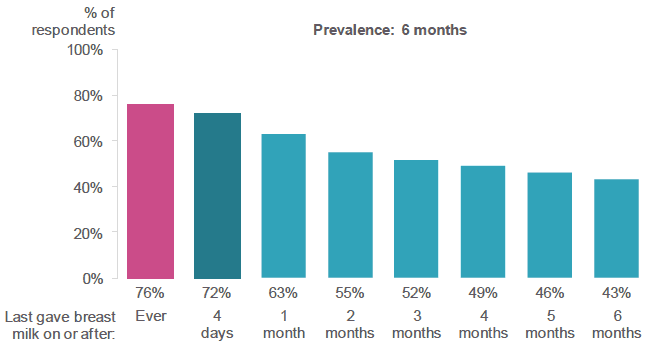
Source: Q26, Q28, 8-12 Month Survey
The 2010 IFS reported that the initial rate for Scottish respondents fell from 74% to 64% by the time that infants were four days old, to 39% by four months, and to 32% by six months. ( R7) This suggests that, although the initial incidence of giving breast milk has changed little in Scotland since 2010, mothers who do give breast milk are now doing so for longer. However, care must be taken when interpreting any differences in results between the two surveys. [24]
Prevalence in the first six months by age and deprivation (8-12 month survey)
There was some variation in the prevalence of giving breast milk at six months depending on the respondent's age and deprivation in their area of residence:
Initial rates for respondents aged 20-24 more than halved, from 64% to 30% by the time infants were six months old (a drop of 34 percentage points).
- Amongst mothers aged 35 and over the initial rate fell from 84% to 55% at six months (29 percentage point drop).
- For respondents who lived in the most deprived areas, the initial rate fell from 69% to 35% at six months (34 percentage point drop).
- The equivalent figures for those who lived in the least deprived areas were 88% to 56% respectively (32 percentage point drop).
[Figure 5.9; Table 5.8a & 5.8b]
Prevalence of giving breast milk at six months varied by respondent age and deprivation.
Figure 5.9: Prevalence of giving breast milk by age and deprivation. (Percentage of respondents giving breast milk to their new baby ever and at six months, by respondent age and deprivation). [25]
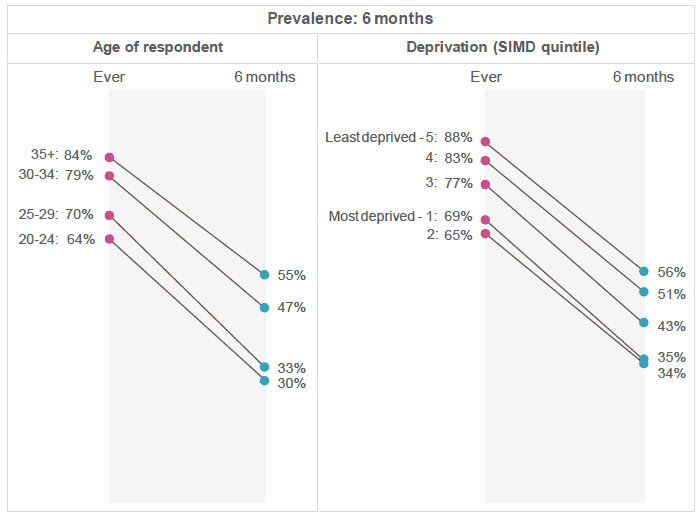
Source: Q26, Q28, Q50, 8-12 Month Survey
Prevalence in the first six months by other factors (8-12 month survey)
There was a difference in the prevalence of infants receiving breast milk at six months old depending on whether the respondent was a first time mother or not.
- 41% of first time mothers were giving breast milk at six months; the equivalent figure for respondents who already had children was 46%.
Note that results from the 8-12 week survey showed wide variation in incidence and prevalence rates amongst mothers who already had children, depending on previous feeding experience. Analysis by previous feeding experience was not possible for the 8-12 month survey.
[Table 5.8c]
5.4 Drop-off in giving breast milk
Drop-off is defined as the proportion of respondents, who had given breast milk at some stage, who had stopped giving breast milk by a specified age. The results in this section focus only on mothers who had given breast milk and exclude mothers who had not.
Drop-off in the first six weeks (8-12 week survey)
In the 8-12 week survey, 92% of respondents who had ever given breast milk to their new baby were still doing so when their infant was four days old (8% had stopped giving breast milk). At one week, the proportion of respondents still giving breast milk had fallen to 88% (11% drop-off). This drop-off continued with each passing week and at the time infants were six weeks of age, 73% of respondents were still giving breast milk (26% drop-off). [26]
[Figure 5.10; Table 5.9a]
Nearly three-quarters of respondents who had been giving breast milk were still giving breast milk when their baby was six weeks old.
Figure 5.10: Drop-off in giving breast milk. (Percentage of respondents who were still giving breast milk at or after a various time periods up to six weeks. Respondents who gave breast milk). [26]
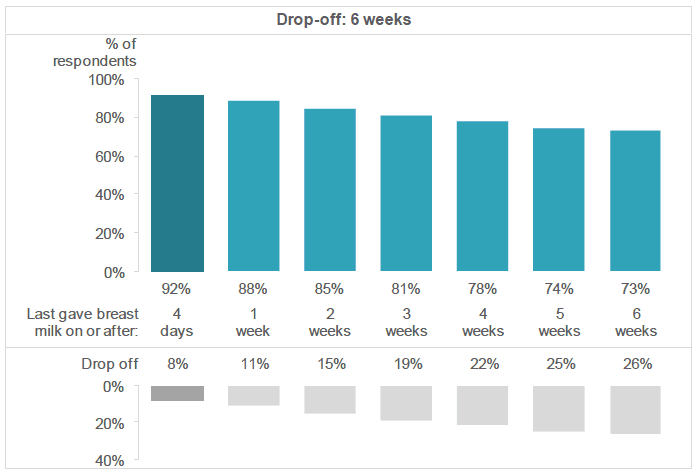
Source: Q31, 8-12 Week Survey
The 2010 IFS reported that 87% of Scottish respondents who had ever given breast milk were still doing so when their infant was four days old (13% drop-off). This fell to 83% at one week (17% drop-off), 79% at two weeks (21% drop-off) and to 67% at six weeks (33% drop-off). ( R7)
Drop-off in the first six weeks by other factors (8-12 week survey)
Age and deprivation were associated with a drop-off in giving breast milk at six weeks:
- Respondent age: Drop-off rates were highest amongst younger mothers. Fifty-four percent (54%) of mothers aged 20-24 who had given breast milk at some stage were still giving breast milk at six weeks (44% drop-off). This compared to 79% of mothers aged 35 and over (21% drop-off).
- Deprivation: Drop-off rates were also highest amongst respondents who lived in the most deprived areas, however differences between deprivation groups were less marked than those observed between respondents of different ages. Sixty-nine percent (69%) of mothers who lived in the most deprived areas were still giving breast milk at six weeks (29% drop-off). This compared to 78% of mothers living in the least deprived areas (22% drop-off).
[Table 5.9a & 5.9b]
As with prevalence, there were a number of other factors associated with a drop-off in infants receiving breast milk at six weeks:
- Feeding intention prior to birth: Eighty percent (80%) of mothers who had intended to breastfeed / express milk only before their baby was born were still giving breast milk at six weeks. This compared to 52% of those who had intended to mix feed and 46% of those who had been undecided. Only a very small number of respondents who intended to formula feed went on to give breast milk (< 30); therefore no drop-off analysis has been presented for this group.
- Previous feeding experience: Sixty-eight percent (68%) of first time mothers were still giving breast milk at six weeks. Amongst mothers who already had children, results varied according to the length of time that a mother had previously given breast milk (previous mothers who had never given breast milk 56%; previously given for < 2 months 39%; 2- < 6 months 82%; 6+ months 98%).
- Feeding method(s) on leaving hospital: Eighty-six percent (86%) of respondents who were exclusively giving breast milk when they left hospital were still giving breast milk at six weeks, compared to 53% of those who were mix feeding on leaving hospital. Only 11% of mothers who had been exclusively giving formula milk when they left hospital were giving breast milk at six weeks.
[Table 5.9c & 5.9d & 5.9e]
Drop-off: how babies were being fed at 8-12 weeks
Sixty-nine percent (69%) of respondents to the 8-12 weeks survey, who had ever given breast milk to their new baby, were still doing so at the time of survey completion; 49% were exclusively giving breast milk, while a further 19% were mix feeding. The remaining 31% were giving formula milk to their babies.
[Figure 5.11; Table 5.10a]
Half of respondents, who had ever given breast milk to their new baby, were exclusively giving breast milk at the time of survey completion (8-12 week survey).
Figure 5.11: Are you still breastfeeding or expressing breast milk for your baby now? (Percentage of respondents who indicated each feeding method. Respondents who gave breast milk).
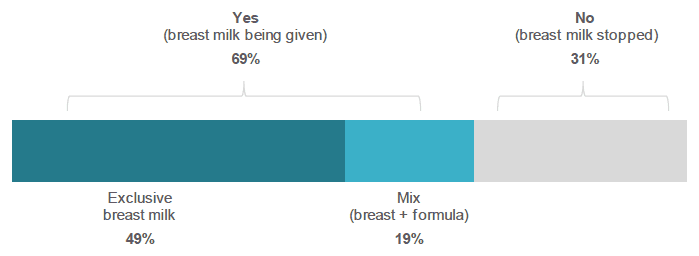
Source: Q30, 8-12 Week Survey
The 2016/17 official national Infant Feeding Statistics for Scotland reported that, amongst infants who had ever been given breast milk, 65% were still being given breast milk at the time of their 6-8 week Health Visitor review. Forty-eight percent (48%) were receiving breast milk exclusively and 17% were being mix fed. The remaining 35% were no longer receiving breast milk and were being given formula milk only. ( R9)
Within the current survey, 71% of infants aged six to less than nine weeks, who had ever been given breast milk, were receiving breast milk at the time of survey completion. Fifty-one percent (51%) were being given breast milk exclusively, 20% were being mix fed, and 29% were being given formula milk only.
[Table 5.10a]
As noted in section 5.1, the current survey is likely to overestimate the true rates of women giving breast milk both initially and in the weeks following a baby's birth. The rates presented in the official national Infant Feeding Statistics for Scotland should be regarded as the definitive source of this information.
Nearly two-thirds of respondents (64%) who were giving breast milk only when they left hospital / the maternity unit indicated that they were exclusively giving breast milk when they completed the 8-12 week survey. This compared to 16% of those who were mix feeding on leaving hospital and 3% of mothers who had been exclusively giving formula milk.
[Figure 5.12; Table 5.10b]
Nearly two-thirds of respondents who were giving breast milk only when they left hospital were exclusively giving breast milk at the time of survey completion (8-12 week survey).
Figure 5.12: Are you still breastfeeding or expressing breast milk for your baby now? (Percentage of respondents who indicated each feeding method, by feeding method(s) on leaving hospital. Respondents who gave breast milk).
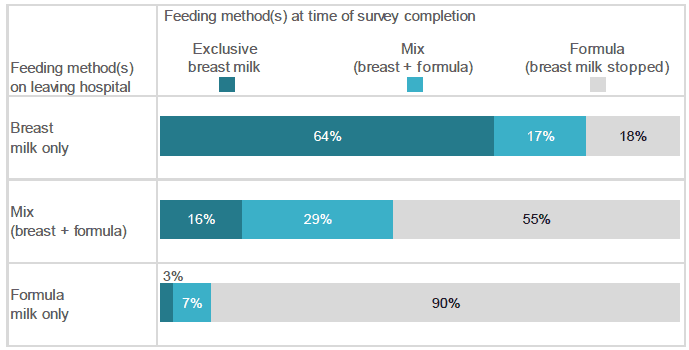
Source: Q30, Q32, 8-12 Week Survey
Drop-off in the first six months (8-12 month survey)
In the 8-12 month survey, 94% of respondents who had ever given breast milk to their new baby were still doing so when their infant was four days old (5% had stopped giving breast milk). At one month, the proportion of respondents still giving breast milk had fallen to 83% (17% drop-off). This drop-off continued with each passing month and at the time infants were six months of age, 57% of respondents were still giving breast milk (43% drop-off). [27]
[Figure 5.13; Table 5.11a]
More than half of respondents who had been giving breast milk were still giving breast milk when their baby was six months old.
Figure 5.13: Drop-off in giving breast milk. (Percentage of respondents who were still giving breast milk at or after a various time periods up to six months. Respondents who gave breast milk). [27]
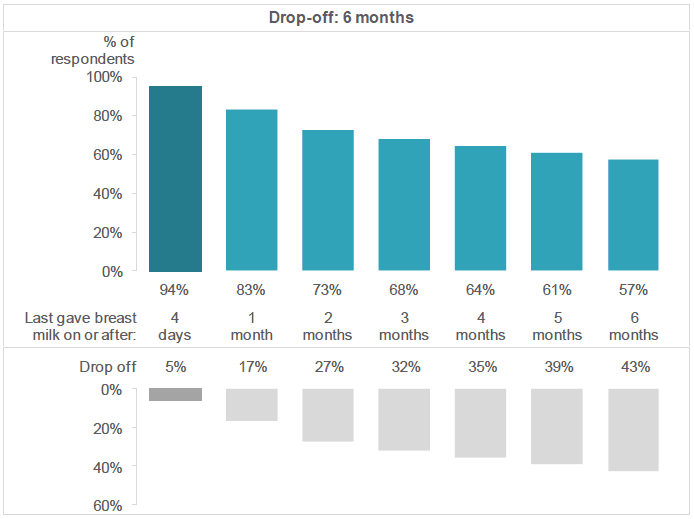
Source: Q28, 8-12 Month Survey
The 2010 IFS reported that 87% of Scottish respondents who had ever given breast milk were still doing so when their infant was four days old (13% drop-off). This fell to 52% at four months (48% drop-off) and to 43% at six months (57% drop-off). ( R7) This suggests that mothers who give breast milk now are doing so for longer than they did in 2010. The 2010 IFS found that between 2005 and 2010 there was also an increase in duration of breastfeeding in Scotland. However, care must be taken when interpreting any differences in results between the IFS and this survey. [28]
Drop-off in the first six months by other factors (8-12 month survey)
Age and deprivation were associated with a drop-off in giving breast milk at six months:
- Respondent age: Drop-off rates at six months were highest amongst younger mothers. Forty-six percent (46%) of mothers aged 20-24 who had given breast milk at some stage were still doing so at six months (54% drop-off). This compared to 66% of mothers aged 35 and over (34% drop-off).
- Deprivation: Drop-off rates at six months were also highest amongst respondents who lived in the most deprived areas. Fifty-one percent (51%) of mothers who lived in the most deprived areas were still giving breast milk at six months (49% drop-off). This compared to 64% of mothers living in the least deprived areas (36% drop-off).
[Table 5.11a & 5.11b]
There was a difference in drop-off in giving breast milk at six months depending on whether the respondent was a first time mother or not:
- 52% of first time mothers who had given breast milk at some stage were still doing so at six months (48% drop-off); the equivalent figure for respondents who already had children was 64% (36% drop-off)).
Note that results from the 8-12 week survey showed wide variation in drop-off rates amongst mothers who already had children, depending on previous feeding experience. Analysis by previous feeding experience was not possible for the 8-12 month survey.
[Table 5.11c]
5.5 Breastfeeding challenges
As previously indicated, 75% of respondents to the 8-12 week survey reported that they had given breast milk to their new baby at some point. Of these respondents, 67% reported that they had experienced problems while breastfeeding or expressing milk. The proportion of respondents who had experienced problems varied amongst different groups:
- Respondents who had stopped giving breast milk to their baby were more likely to have experienced breastfeeding / expressing problems (80%) than those who were mix feeding (69%) or those who were giving breast milk exclusively (58%).
- 75% of first time mothers reported that they had experienced problems. Amongst mothers who already had children, results varied according to the length of time that a mother had previously given breast milk (previous mothers who had never given breast milk 64%; previously given for < 2 months 69%; 2- < 6 months 61%; 6+ months 53%).
[Table 5.12a & 5.12b]
Amongst respondents who had experienced a problem breastfeeding or expressing milk, the types of problems reported varied according to when the problem had been experienced.
- The most common issues reported while respondents were still in hospital related to attachment issues (52%) and concerns around milk supply (44%). Forty-two percent (42%) of respondents indicated that they had experienced difficulty in attaching the baby to the breast themselves while in hospital, and 34% said that the baby wouldn't attach at the breast. Twenty-eight percent (28%) were worried about how much milk their baby was getting.
- While still in hospital, infant issues such as a baby being sleepy and reluctant to feed (23%), a baby being premature, small or unwell (11%), or the need for a baby to be tested for hypoglycaemia (10%) were mentioned reasonably frequently. However, these issues were mentioned less often after the respondent had gone home.
- When at home, within two weeks of the birth, attachment issues were still apparent (37%), but concerns around milk supply (65%) and maternal issues (65%) became more prominent. At this stage, 41% indicated that they were worried about how much milk their baby was getting and 42% reported prolonged or frequent feeds. Fifty-three percent (53%) of respondents reported having sore nipples at this stage.
- While at home, more than two weeks after the birth, attachment issues were much less evident (13%), but concerns around milk supply were still reported frequently (44%). Thirty-one percent (31%) of respondents reported prolonged or frequent feeds at this stage, but they seemed less worried about how much milk their baby was getting than before (22%). A quarter of respondents (25%) reported having sore nipples more than two week after the birth.
[Figure 5.14; Table 5.13]
Challenges around attachment to the breast were reported frequently while respondents were still in hospital. Concerns around milk supply and maternal issues became more prominent after leaving hospital.
Figure 5.14: Have you had any of the following problems breastfeeding or expressing breast milk for your baby and, if so, when did these problems arise? (Percentage of respondents who selected each type of problem / location. Respondents who gave breast milk and experienced a problem. Most common problems highlighted). [29]
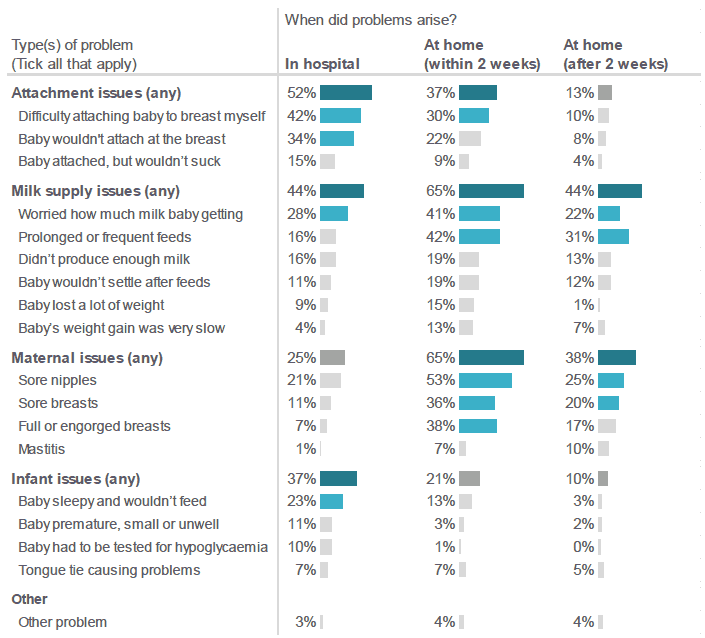
Source: Q36, 8-12 Week Survey
It should be noted that some respondents stopped giving breast milk before leaving hospital / before two weeks. It is possible that some issues that were mentioned frequently shortly after giving birth were reported less frequently thereafter because the respondents who were experiencing these issues had stopped giving breast milk.
Amongst respondents who had experienced a breastfeeding / expressing problem, the types of problems reported varied between mothers who had stopped breastfeeding / expressing and those who were still giving breast milk.
[Figure 5.15; Table 5.14]
Respondents who had stopped giving breast milk frequently reported challenges around attachment to the breast and concerns about milk supply.
Figure 5.15: Have you had any of the following problems breastfeeding or expressing breast milk for your baby? (Percentage of respondents who selected each type of problem, by whether respondent is still breast feeding. Respondents who gave breast milk and experienced a problem. Most common problems highlighted in blue).
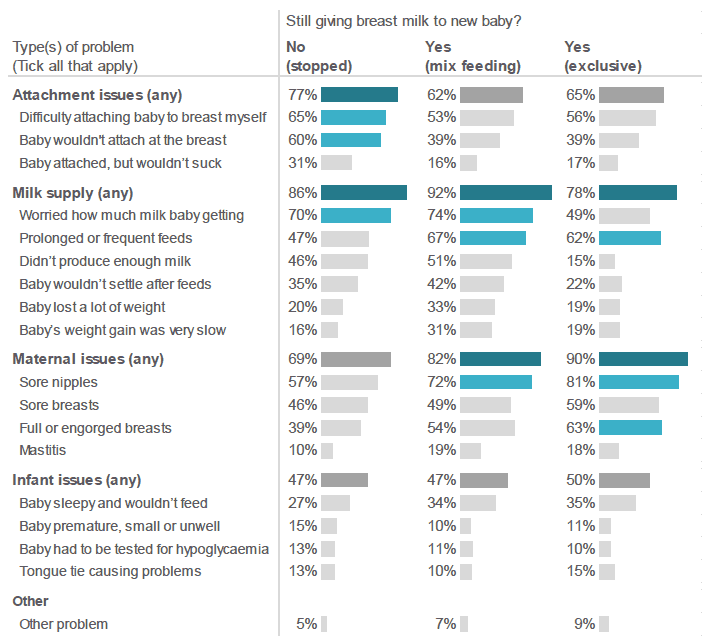
Source: Q36, Q30, 8-12 Week Survey
- Attachment issues were frequently mentioned by respondents who had stopped breastfeeding / expressing breast milk for their new baby (77%). Sixty-five percent (65%) of these respondents indicated that they had experienced difficulty in attaching the baby to the breast themselves, and 60% said that the baby wouldn't attach at the breast. Supply issues were also very prominent amongst respondents who had stopped giving breast milk (86%), with 70% indicating that they were worried about how much milk their baby was getting.
- Concerns around milk supply were also mentioned by the vast majority of respondents (92%) who were mix feeding their baby at the time of survey completion. Nearly three-quarters (74%) of these respondents said that that they were worried about how much milk their baby was getting and 67% reported prolonged or frequent feeds. Maternal issues such as sore nipples were also frequently mentioned by mothers who were mix feeding (72%).
- Amongst respondents who were still giving breast milk to their baby, the most frequently reported challenges were related to maternal issues (90%). Eighty-one percent (81%) of these respondents reported experiencing sore nipples and 63% reported full or engorged breasts. Sixty-two percent (62%) of this group also reported milk supply issues relating to prolonged or frequent feeds.
[ Figure 5.15; Table 5.14]
Help and information with breastfeeding / expressing challenges
Eight-nine percent (89%) of respondents who had experienced problems with breastfeeding or expressing got help with and/or information about these problems; however 11% did not receive help / information.
[Table 5.15]
- Respondents most frequently indicated that they had received help / information from Midwives and Maternity Staff (91%). Of those who had received support from this source the majority indicated that it had been easy to access (89%) and helpful (83%).
- Health Visitors were also frequently cited as a source of support for breastfeeding / expressing challenges (74%). Ninety-four percent (94%) of respondents who had received help / information from a Health Visitor said that it had been easy to access; 85% reported that it had been helpful.
- Other sources of support were reported less frequently; family and friends (50%), a local breastfeeding group (24%), a NHS breastfeeding support worker (19%), a NHS Infant Feeding Advisor (16%), or a counsellor / consultant / supporter from a voluntary organisation (16%). Where used, respondents generally found this type of help easy to access and helpful (often "very helpful").
- 13% of respondents had sought help / information from their GP. While this was reasonably easy to access (86%), 10% of respondents who had received help / information from their GP had not found it helpful (5% reported that it was "not helpful at all").
- 8% of mothers had received help / information from a NHS tongue tie clinic. In contrast to other sources of support, 23% of these respondent reported that this had not been easy to access. However, where accessed, 82% of respondents had found this help / information helpful (66% "very helpful").
[Figure 5.16; Table 5.16a & 5.16b & 5.16c]
Respondents frequently got information and help for breastfeeding problems from their Midwife and/or Health Visitor.
Figure 5.16: Who gave you information about and/or help with these breastfeeding problems? (Percentage of respondents. Respondents who got information / help with problems).
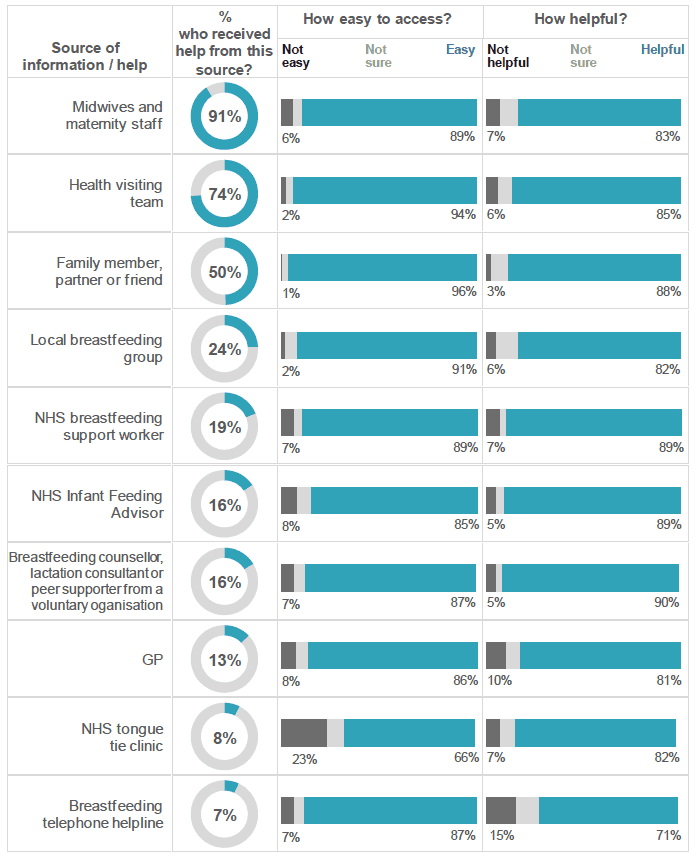
Source: Q38, 8-12 Week Survey
Only seven percent (7%) of respondents who had received help / information about breastfeeding / expressing problems had received this support from the breastfeeding telephone helpline. Generally speaking, respondents who had used this service had found it easy to access (87%), but 15% had not found it to be helpful (6% reported that it was "not helpful at all").
It should be noted that, unlike the other sources of support asked about in this survey, the telephone helpline does not provide face-to-face support for mothers who are experiencing breastfeeding / expressing problems. This point should be borne in mind when interpreting these results.
[ Figure 5.16; Table 5.16a & 5.16b & 5.16c]
Amongst all respondents to the 8-12 week survey who had ever given breast milk to their new baby, 59% were aware of the National Breastfeeding Helpline and 6% reported that they had used it.
[Table 5.17]
5.6 Stopping breastfeeding / expressing milk
Overall, three-quarters (75%) of respondents to the two postnatal surveys, who had stopped giving breast milk to their new baby, reported that they would have like to have given breast milk for longer.
However, amongst respondents who had given breast milk for six months or more the majority reported that they had breastfed / expressed for as long or for longer than intended (47% had given breast milk for as long as intended; 17% had given breast milk for longer than intended).
[Figure 5.17; Table 5.18]
Most respondents who breastfed / expressed milk for less than six months would like to have done so for longer.
Figure 5.17: Which of the following statements best describes how long you breastfed / expressed breast milk for your new baby? (Percentage of respondents who selected each statement, by age baby last had breast milk. Respondents who gave breast milk, but who have now stopped).
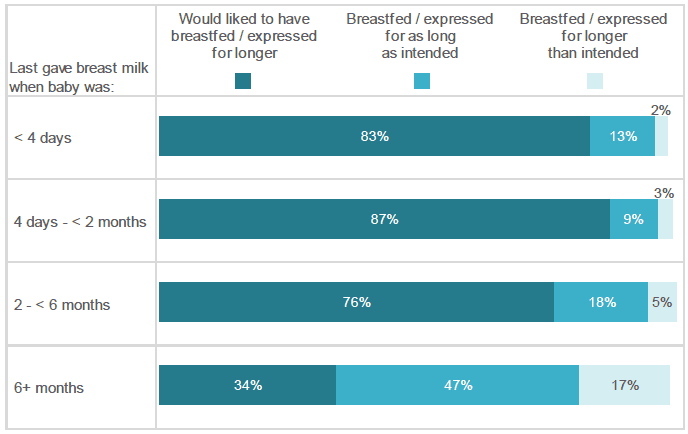
Source: Q31, Q44, 8-12 Week Survey
Q28, Q29, 8-12 Month Survey
Reasons for stopping breastfeeding / expressing milk
The predominant reasons given for stopping breastfeeding / expressing milk were feeding problems (49%) and thinking that the baby was not getting enough milk (45%). A quarter of respondents (25%) also indicated that they had found it "too difficult".
Reasons relating to maternal wellbeing, such as being too tired (16%) or being unwell (11%) were mentioned by more than one in ten respondents. Similar numbers reported being unable to breastfeed their new baby and care for their other children (14%).
Only 12% of respondents said that the reason they stopped was that they had given breast milk for as long as or for longer than intended. Nearly one in ten (9%) said that they did not get enough support from their Doctor / Midwife / Health Visitor.
[Figure 5.18; Table 5.19]
Feeding problems and worries about how much milk the baby was getting were the main reasons respondents stopped breastfeeding / expressing milk.
Figure 5.18: What were the reasons you decided to stop breastfeeding / expressing breast milk? (Percentage of respondents who selected each reason. Respondents who gave breast milk, but who have now stopped).
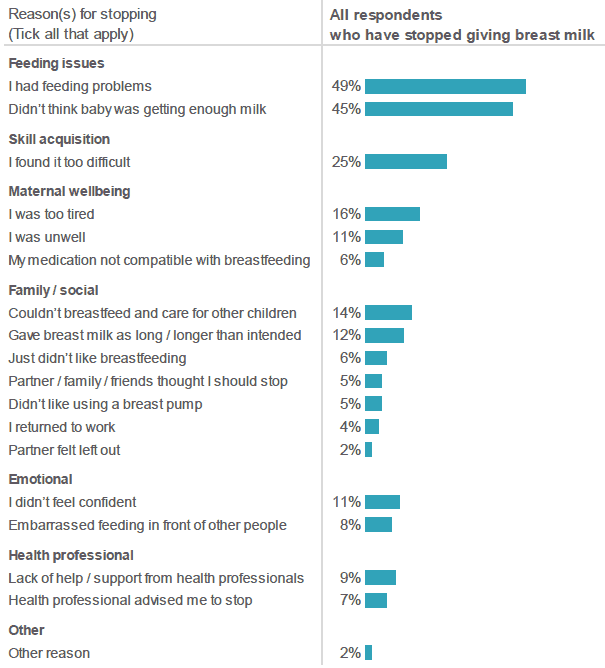
Source: Q45, 8-12 Week Survey
Q30, 8-12 Month Survey
Reasons for stopping breastfeeding / expressing milk varied depending on when the respondent had stopped giving breast milk to her new baby.
[Figure 5.19; Table 5.19]
Reasons for stopping breastfeeding / expressing varied depending on when the respondent stopped.
Figure 5.19: What were the reasons you decided to stop breastfeeding / expressing breast milk? (Percentage of respondents who selected each reason, by age baby last had breast milk. Respondents who gave breast milk, but who have now stopped. Most common problems highlighted in blue).
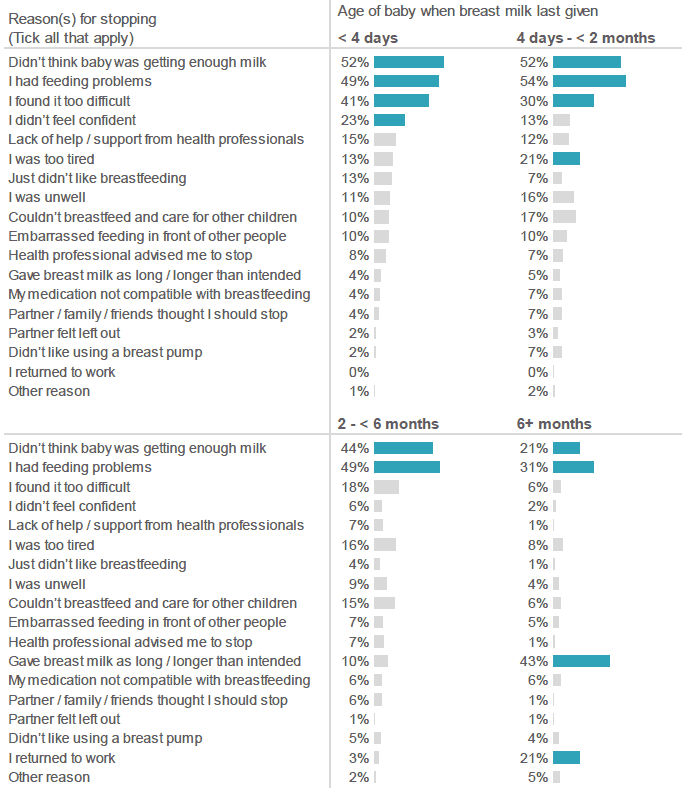
Source: Q45, Q31, 8-12 Week Survey
Q30, Q28, 8-12 Month Survey
- Around half of respondents (52%) who stopped giving breast milk before their baby was four days old indicated that they had done so because they did not think their baby was getting enough milk. A similar proportion (49%) said that they had stopped due to feeding problems and 41% said that they had found it too difficult. Nearly a quarter of these respondents (23%) indicated that they had stopped giving breast milk because they did not feel confident.
- Concerns around the baby getting enough milk and feeding problems remained important reasons for stopping breastfeeding / expressing for respondents who stopped after four days, but before six months. However, difficulty and lack of confidence and were mentioned progressively less frequently as duration of breastfeeding / expressing increased.
- Respondents who breast fed / expressed for six months or more still indicated that they had stopped because they did not think their baby was getting enough milk and/or due to feeding problems (21% and 31% respectively). However, 43% of these respondents said that they had stopped because they had breastfed or expressed milk for as long or for longer than intended. Twenty-one percent (21%) said that they had stopped because they had returned to work.
[ Figure 5.19; Table 5.19]
The main reasons for stopping breastfeeding / expressing milk were similar for first time mothers and those who had previously had children. However, more than a third of respondents (35%) who already had children said that they had stopped because they were unable to breastfeed their new baby and care for their other children.
[Table 5.20]
In the 2010 UK-wide Infant Feeding Survey, feeding problems and worries around milk supply issues were also frequently mentioned as reasons for stopping breastfeeding / expressing milk. Reasons also varied according to the length of time that mothers chose to breastfeed / express milk. ( R7) However, due to differences in methodology and in how this question was asked, it is not possible to directly compare results between the 2010 survey and this survey.
Help and encouragement to continue breastfeeding / expressing milk
Around a quarter of respondents to the 8-12 week survey who had stopped breastfeeding / expressing milk thought that access to certain types of support would have helped and encouraged them to breastfeed / express milk for longer:
- 27% thought that an NHS Infant Feeding Advisor would have helped (11% definitely; 16% probably).
- 26% thought that an NHS Breastfeeding Support Worker would have helped (11% definitely; 15% probably).
- 24% thought that a free-to-borrow electric breast pump would have helped (13% definitely; 11% probably).
- 19% thought that access to a voluntary organisation would have helped (7% definitely; 12% probably).
[Figure 5.20; Table 5.21]
Around a quarter of respondents indicated that access to certain types of support would have helped and encouraged them to breastfeed / express milk for longer.
Figure 5.20: Would access to any of the following have helped and encouraged you to breastfeed / express for longer? (Percentage of respondents who selected each response. Respondents who gave breast milk, but who have now stopped).
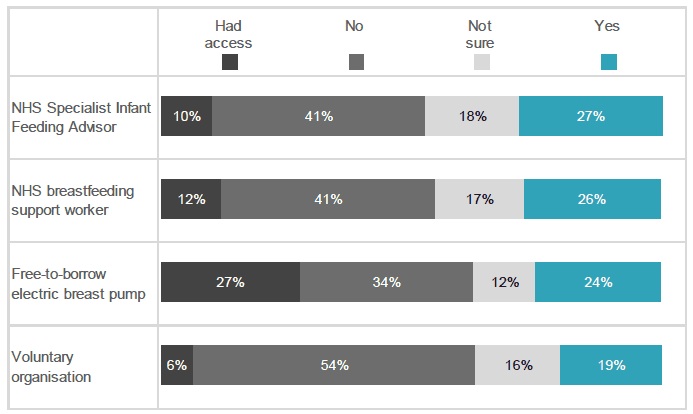
Source: Q46, 8-12 Week Survey
5.7 Breast fed infants who were also given formula milk
Respondents to the 8-12 week survey who had ever given breast milk were asked whether they had ever given their baby any infant formula. Overall, two-thirds of these respondents (66%) reported that they had given some formula milk to their baby:
- 33% had first given infant formula when they were still in hospital (or if a home birth, within the first 48 hours).
- 17% had first given infant formula at home within two weeks of the birth.
- 16% had first given formula at home more than two weeks after the birth.
[Figure 5.20; Table 5.22]
Two-thirds of respondents who had given breast milk had also given infant formula milk to their new baby.
Figure 5.20: Has your baby ever been given infant formula milk? / Please indicate when you baby was first given infant formula milk. (Percentage of respondents who selected each response. Respondents who gave breast milk).
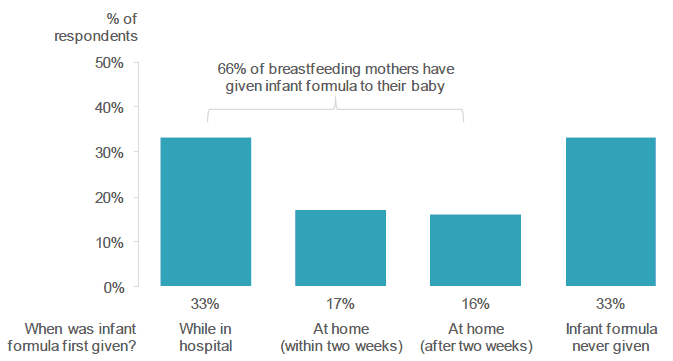
Source: Q41, Q40, 8-12 Week Survey
Frequency of infant formula use
Respondents who had given breast milk were asked how often their baby had been given infant formula. If their pattern of usage had varied, respondents were asked to indicate their current situation. Around a third (34%) reported that their babies were being fed infant formula at every feed or almost all feeds, however in 10% of cases formula had only been given once or twice since birth.
[Figure 5.21; Table 5.23]
A third of respondents who had given breast milk were giving formula at every feed or almost all feeds.
Figure 5.21: How often has your baby been fed infant formula? (Percentage of respondents who selected each response. Respondents who gave breast milk).
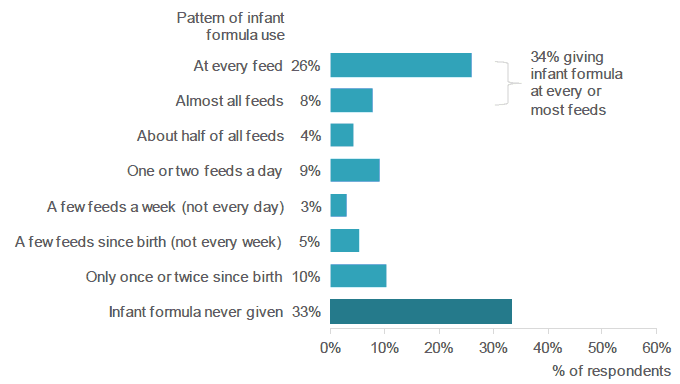
Source: Q43 , Q40 , 8-12 Week Survey
Reasons for giving infant formula
Reasons for introducing infant formula varied according to when it was first given.
- Respondents who introduced formula while in hospital frequently did so because of breastfeeding problems (49%), because a health professional had advised them to (36%), or because they were anxious about how much milk their baby was getting and decided to give a formula supplement (31%). Other reasons not listed in the survey, but specifically mentioned by respondents, were the baby being premature or in special care (5%), the mother or baby being unwell (3%) or the baby having hypoglycaemia (3%).
- Amongst those who introduced formula within the first two weeks at home, reasons relating to breastfeeding problems rose to 61%. Anxiety about how much milk the baby was getting was also reported by 44% of these respondents. Thirty-four percent (34%) said that they had introduced formula on the advice of a health professional at this stage.
- The most common reasons for introducing formula after two weeks were to make breastfeeding more manageable (33%) and because it allowed the respondent's partner to be involved (31%). However, breastfeeding problems (28%) and anxiety about the how much milk the baby was getting (23%) were still mentioned by many respondents at this stage. A variety of other reasons not listed in the survey, such as the mother or baby being unwell (4%), were also mentioned at this stage.
[Figure 5.22; Table 5.24]
Reasons for introducing infant formula varied depending on when it was first given.
Figure 5.22: What were the reasons you decided to give infant formula? (Percentage of respondents who selected each reason, by when infant formula was first given. Respondents who gave breast milk and who also gave infant formula. Most common reasons highlighted in blue).
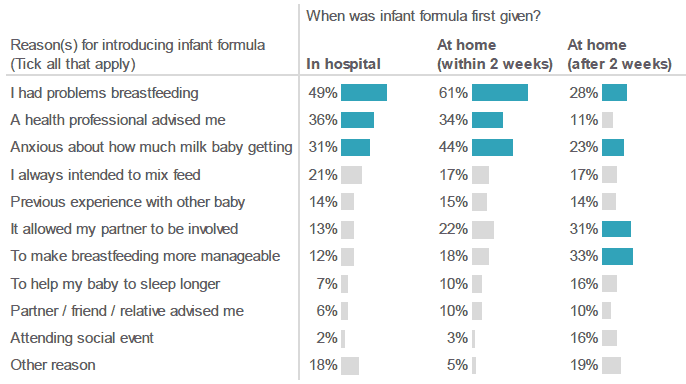
Source: Q42, 8-12 Week Survey
5.8 Breastfeeding in public and in the home
Sixty-eight percent (68%) of respondents to the 8-12 month survey, who had ever given breast milk to their new baby, had breastfed in a public place – i.e. somewhere other than the hospital where they gave birth or in their own home.
[Table 5.25]
Amongst all mothers who had given breast milk to their new baby, nearly a quarter (23%) indicated that they had been made to feel uncomfortable when breastfeeding their baby. One in ten (10%) had been made to feel uncomfortable in someone else's home or in a café or restaurant; 6% said that they had been made to feel uncomfortable in their own home.
Three percent (3%) of respondents said that they had been made uncomfortable in a NHS facility such as a hospital, clinic or GP surgery.
Note that many respondents had not breastfed in some places listed in the survey.
[Figure 5.23; Table 5.26a]
One in ten respondents had been made to feel uncomfortable when breastfeeding their baby in someone else's home or in a café or restaurant.
Figure 5.23: Have you ever been made to feel uncomfortable when breastfeeding your baby in any of the following places? (Percentage of respondents who indicated that they had been made to feel uncomfortable in each place. Respondents who gave breast milk).
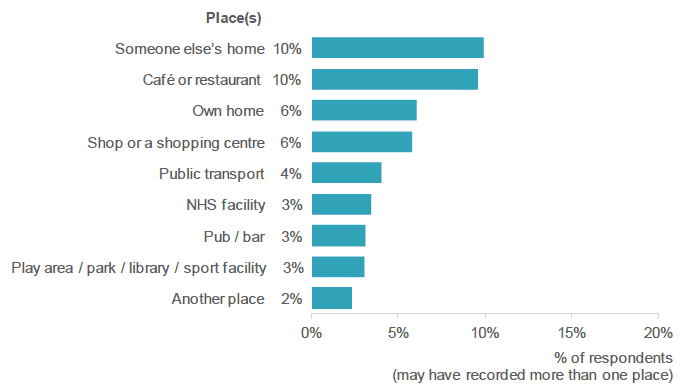
Source: Q32, 8-12 Month Survey
More than a quarter (27%) of respondents had sometimes decided not to breastfeed their baby in a certain place because they thought they would be made to feel uncomfortable.
The most common places where respondents had decided not to breastfeed were in a cafe / restaurant (15%), on public transport (14%), in a pub / bar (14%), or in a shop / shopping centre (12%).
[Figure 5.24; Table 5.26b]
Respondents sometimes decided not to breastfeed their baby in a certain place because they thought they would be made to feel uncomfortable.
Figure 5.24: Have you ever decided not to breastfeed your baby in any of the following places because you thought you would be made to feel uncomfortable? (Percentage of respondents who indicated that they had decided not to breastfeed in each place. Respondents who gave breast milk).
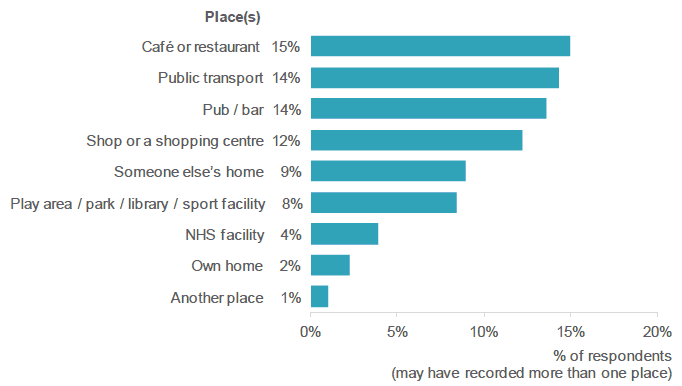
Source: Q33, 8-12 Month Survey
Scotland is one of the few countries in the world to have legislation protecting the right to feed (Breastfeeding etc (Scotland) Act 2005). ( R30) Under this legislation, it has been illegal to prevent a child under two years of age being fed milk (breast or formula) in a public place in Scotland, providing the child is lawfully permitted to be in that place. Despite this, 3% of respondents reported that they had been asked either not to breastfeed, or to stop breastfeeding, in a certain place (67 respondents (unweighted)). This included:
- 18 cases in someone else's home. [30]
- 16 cases in a café or restaurant.
- 14 cases on public transport.
- 12 cases around a children's' play area / park / library / sport facility.
- 11 cases in a shop or a shopping centre.
Other cases were mentioned in a NHS facility (8), a pub / bar (7), and in the respondent's own home (7) *. Eleven cases were reported in other locations not listed in the survey.
[Table 5.26c]
Contact
There is a problem
Thanks for your feedback